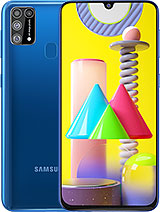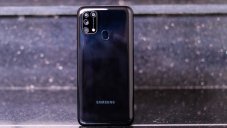Samsung Galaxy M31
$183 | 16499
- 6.4" 1080x2340 pixels
- 64MP 2160p
- 6GB RAM Exynos 9611
- 6000mAh Li-Po
Phone Finder
- Acer alcatel Allview Amazon Amoi Apple Archos Asus AT&T Benefon BenQ BenQ-Siemens Bird BlackBerry Blackview BLU Bosch BQ Casio Cat Celkon Chea Coolpad Cubot Dell Doogee Emporia Energizer Ericsson Eten Fairphone Fujitsu Siemens Garmin-Asus Gigabyte Gionee Google Haier HMD Honor HP HTC Huawei i-mate i-mobile Icemobile Infinix Innostream iNQ Intex itel Jolla Karbonn Kyocera Lava LeEco Lenovo LG Maxon Maxwest Meizu Micromax Microsoft Mitac Mitsubishi Modu Motorola MWg NEC Neonode NIU Nokia Nothing Nvidia O2 OnePlus Oppo Orange Oscal Oukitel Palm Panasonic Pantech Parla Philips Plum Posh Prestigio QMobile Qtek Razer Realme Sagem Samsung Sendo Sewon Sharp Siemens Sonim Sony Sony Ericsson Spice T-Mobile TCL Tecno Tel.Me. Telit Thuraya Toshiba Ulefone Umidigi Unnecto Vertu verykool vivo VK Mobile Vodafone Wiko WND XCute Xiaomi XOLO Yezz Yota YU ZTE
Samsung Galaxy M31 Summary
Since its launch, Samsung's Galaxy M series has gained a foothold in the market thanks to its affordable price and reasonable configuration. In fact, last year, the arrival of the Galaxy M30s certainly made many Galaxy A50s users feel disappointed: Except for a more eye-catching design and an in-display fingerprint sensor, the Galaxy A50s is basically identical to the Galaxy M30s, with significantly lower battery capacity and a starting price of nearly Rs. 3,000 higher.
At the launch event of the Galaxy M31, Samsung once said that the camera, battery life and display quality are the most important factors for today's young users. The 6,000 mAh battery capacity gives the Galaxy M30s a very good battery life, and perhaps the quality of Samsung's Super AMOLED screen is no longer in question. Therefore, it is not difficult to understand when the camera is the main goal of the Galaxy M31 upgrade. The Samsung Galaxy M31 price in India is Rs. 16,499, which is at in the same price range as the Redmi Note 9 Pro, Realme Narzo 10A, and more.
Still water drop design, not update to the punch-hole trend
After first appearing on the Galaxy Note 10 and Note 10+ flagships, the punch-hole Infinity-O display design is becoming increasingly popular in Samsung smartphones. However, it seems that to save costs, the design hasn’t been popularly used on the Galaxy M smartphones, instead, it is still the Infinity-U water-drop design, which is now mostly seen in budget smartphones only.
Screen: Satisfied with Super AMOLED panel quality
The Galaxy M31 is equipped with a 6.4-inch screen, 2340x1080 pixel resolution, Super AMOLED panel protected by Gorilla Glass 3. By default, the device will display in Vivid mode for more vibrant colors.
The quality of Samsung's Super AMOLED panel is something that has been affirmed, and there is not much difference between devices in the same segment.
Clearly upgraded camera
Following the Galaxy A and Galaxy S, Galaxy M31 becomes the first Galaxy M series smartphone to be equipped with four rear cameras including a 64MP main camera with ISOCELL Bright GW1 sensor, a 5MP dedicated macro camera, a 5MP depth-of-field camera, and an 8MP ultra-wide-angle camera. At the front, the selfie camera has been upgraded to a 32MP unit
By default, the primary 64MP camera captures images at 16MP using pixel binning. You can shoot in full 64MP resolution but the camera will not support HDR, in addition to taking a longer time while the quality is not different. So in most cases, you just need to use the default 16MP mode.
With the major upgrade on the main camera, it's not surprising that the quality of photos taken by the Galaxy M31 is much better than its predecessors. In bright enough conditions, the 64MP main camera produces rich, detailed images, while colors are boosted brighter than usual but not harsh, bright, and wide contrast range. The HDR feature handles the light difference well in most cases.
When shooting in low light conditions, the Galaxy M31 tends to push the brightness of the image higher, accepting lower detail. The night shooting feature helps improve the detail, provided that you have to hold your hand firmly or have a tripod. However, if there is barely any light, it will not be able to deliver a good job
Performance: Sufficient for everyday use & Mediocre gaming performance
The "heart" of the Galaxy M30s, Exynos 9611 chip with 4 cores of Cortex-A73 2.3 GHz and 4 cores of Cortex-A53 clocked at 1.7 GHz is also brought to the Galaxy M31, along with 6GB of RAM and 128GB of internal memory. In this segment, rivals of Exynos 9611 are Snapdragon 712 and Helio G90T.
By default, Galaxy M31 sets a high graphics level on PUBG Mobile, staying at 40 fps, but in fact, the device could not "carry" this setting, resulting in frame drops and rapid heat up. Instead, I chose the lowest graphics setting to get 60 fps, after all, for a game like PUBG Mobile, the number of frames per second is more important than the beautiful graphics. The Galaxy M31's average fps of 49 was not bad, but the fire scenes caused fps to be affected, resulting in frame stability of only 70%.
In practical use, the speed of opening apps or basic tasks such as surfing the web, watching movies, ... of the Galaxy M31 are all as expected in the price range. 6GB RAM is enough for good multitasking capability.
Battery life tops the mid-range segment
Average performance, but Exynos 9611 chip consumes very low level of battery life. With a huge capacity of 6,000 mAh battery, Galaxy M31 owns the battery life that can be said to be at the top of the mid-range segment at the present time.
Verdict
Galaxy M31 is a slight upgrade of the Galaxy M30s in the camera department instead of a comprehensive upgrade product. The long battery life of the Galaxy M30s is inherited by Galaxy M31, even improved. Its camera is on par with more expensive products, which is a great thing. The performance of the device may be better, but that could lower its battery life.
However, the Galaxy M31 still has some minor cons such as the outdated water-drop notch design. However, with what is available on the Galaxy M31, Samsung is holding a very powerful card to conquer the mid-range segment.
Samsung Galaxy M31 Full Specifications
- Dollas $183
- Rupee ₹16499
- Technology GSM / HSPA / LTE
- 2G bands GSM 850 / 900 / 1800 / 1900 - SIM 1 & SIM 2
- 3G bands HSDPA 850 / 900 / 1700(AWS) / 1900 / 2100
- 4G bands 1, 2, 3, 4, 5, 7, 8, 12, 13, 17, 20, 26, 28, 38, 40, 41, 66
- Speed HSPA, LTE-A
- Announced 2020, February 25
- Status Available. Released 2020, March 05
- Dimensions 159.2 x 75.1 x 8.9 mm (6.27 x 2.96 x 0.35 in)
- Weight 191 g (6.74 oz)
- Build Glass front (Gorilla Glass 3), plastic back, plastic frame
- SIM Dual SIM (Nano-SIM, dual stand-by)
- Type Super AMOLED capacitive touchscreen, 16M colors
- Size 6.4 inches, 100.5 cm2 (~84.1% screen-to-body ratio)
- Resolution 1080 x 2340 pixels, 19.5:9 ratio (~403 ppi density)
- Protection Corning Gorilla Glass 3
- OS Android 10.0; One UI 2.0
- Chipset Exynos 9611 (10nm)
- CPU Octa-core (4x2.3 GHz Cortex-A73 & 4x1.7 GHz Cortex-A53)
- GPU Mali-G72 MP3
- Card slot microSDXC (dedicated slot)
- Internal 64GB 6GB RAM, 128GB 6GB RAM
- UFS 2.1
- Modules 64 MP, f/1.8, 26mm (wide), 1/1.72", 0.8µm, PDAF 8 MP, f/2.2, 12mm (ultrawide), 1/4.0", 1.12µm 5 MP, f/2.4, 25mm (macro), 1/5.0", 1.12µm 5 MP, f/2.2, (depth)
- Features LED flash, panorama, HDR
- Video 2160p@30fps, 1080p@30fps, gyro-EIS
- Modules 32 MP, f/2.0, 26mm (wide), 1/2.8", 0.8µm
- Features HDR
- Video 2160p@30fps, 1080p@30fps
- Loudspeaker Yes
- 3.5mm jack Yes
- WLAN Wi-Fi 802.11 a/b/g/n/ac, dual-band, Wi-Fi Direct, hotspot
- Bluetooth 5.0, A2DP, LE
- GPS Yes, with A-GPS, GLONASS, GALILEO, BDS
- NFC Yes (market/region dependent): SM-M315F/DSN
- Radio FM radio, RDS, recording
- USB 2.0, Type-C 1.0 reversible connector
- Sensors Fingerprint (rear-mounted), accelerometer, gyro, proximity, compass
- Non-removable Li-Po 6000 mAh battery
- Charging Fast charging 15W
- Colors Ocean Blue, Space Black, Red
- Models SM-M315F, SM-M315F/DS, SM-M315F/DSN
- SAR 0.52 W/kg (head) 0.69 W/kg (body)
- SAR EU 0.48 W/kg (head) 1.13 W/kg (body)
Samsung Galaxy M31 News

Mobile - Oct 14, 2020
Samsung Galaxy M31 Prime Launched In India: 64MP Quad Cameras & 6,000mAh Battery

Mobile - Oct 12, 2020
Samsung Galaxy M31 Prime Edition Specs & Price In India Confirmed

Mobile - Mar 27, 2020
Samsung Galaxy M31 vs Samsung Galaxy M21: A Very Close Battle

Review - Mar 18, 2020
Samsung Galaxy M31 Review: Quad Rear Cameras & Massive 6,000mAh Battery

Mobile - Feb 29, 2020











